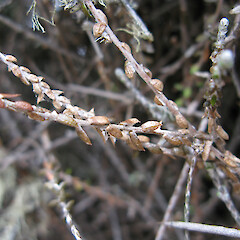Helichrysum dimorphum
Common name
everlasting daisy
Synonyms
None
Family
Asteraceae
Flora category
Vascular – Native
Endemic taxon
Yes
Endemic genus
No
Endemic family
No
Structural class
Lianes & Related Trailing Plants - Dicotyledons
NVS code
The National Vegetation Survey (NVS) Databank is a physical archive and electronic databank containing records of over 94,000 vegetation survey plots - including data from over 19,000 permanent plots. NVS maintains a standard set of species code abbreviations that correspond to standard scientific plant names from the Ngä Tipu o Aotearoa - New Zealand Plants database.
HELDIM
Chromosome number
2n = 28
Current conservation status
The conservation status of all known New Zealand vascular plant taxa at the rank of species and below were reassessed in 2017 using the New Zealand Threat Classification System (NZTCS) – more information about this can be found on the NZTCS website. This report includes a statistical summary and brief notes on changes since 2012 and replaces all previous NZTCS lists for vascular plants.
Please note, threat classifications are often suggested by authors when publications fall between NZTCS assessment periods – an interim threat classification status has not been assessed by the NZTCS panel.
- Conservation status of New Zealand indigenous vascular plants, 2017 . 2018. Peter J. de Lange, Jeremy R. Rolfe, John W. Barkla, Shannel P. Courtney, Paul D. Champion, Leon R. Perrie, Sarah M. Beadel, Kerry A. Ford, Ilse Breitwieser, Ines Schönberger, Rowan Hindmarsh-Walls, Peter B. Heenan and Kate Ladley. Department of Conservation. Source: NZTCS and licensed by DOC for reuse under the Creative Commons Attribution 4.0 International licence.
2017 | Threatened – Nationally Endangered | Qualifiers: Sp
Previous conservation statuses
2012 | Threatened – Nationally Vulnerable | Qualifiers: Sp
2009 | At Risk – Declining | Qualifiers: Sp
2004 | Threatened – Nationally Endangered
Brief description
Rare climbing shrub with untidy brownish twigs inhabiting dry inland Canterbury. Leaves of two types: small (5mm) and narrow with a white underside on the base of twigs and scale-like and embedded in fuzzy stem towards the tip of twigs. Flowers small, dry, at tip of twigs.
Distribution
Endemic. New Zealand: South Island (presently known only from the Poulter, Esk and Puffer catchments where they drain into the Waimakariri River; however, there is also an old record from Piano Flat, Southland).
Habitat
A species of lowland to montane situations. Usually found on river terraces and alongside river gorges. Always in grey scrub, where it is primarily associated with matagouri (Discaria toumatou Raoul) shrubs.
Detailed description
Weakly lianoid, sparingly branched scrambler, producing numerous fine stems up to 8 m long. Juvenile and shade leaves 5 × 2 mm, brown or grey-black, spreading, ovate-oblong, apex subacute and mucronate, upper leaf surface glabrous, under surface covered in white wispy hairs. Leaves of terminal branches or exposed branches overlapping, scale -like, appressed, 3 × 1 mm, linear-lanceolate, strongly keeled, tomentose, base clad in dense, floccose tomentum. Capitula subcylindric, terminal, 3.5 mm diameter, phyllaries (bracts) in 2–3 series, outer bracts oblong, inner narrow-oblong, margins finely toothed. Florets 15–25. Achenes (seeds) narrow-oblong, glabrous, pappus hairs slender and numerous.
Similar taxa
None
Flowering
September–February
Fruiting
October–March
Life cycle
Pappate achenes are dispersed by wind (Thorsen et al., 2009).
Propagation technique
Easily grown from fresh seed and semi-hardwood cuttings. Established plants layer easily. Does best in semi-shade or planted at the base of a shrub through which it can sprawl. Does not like humid climates.
Threats
Seriously threatened by aerial spraying for gorse (Ulex europaeus L.), and by scrub fires. This species often grows within and through matagouri (Discaria toumatou) so it is easily overlooked. Matagouri is easily burned and considered to be a pest in some parts of the country. Clearance of matagouri may have been a factor in the historic decline of Helichrysum dimorphum, and remains a serious potential threat to this day.
Etymology
helichrysum: From the Greek words helios ‘sun’ and chrysos ‘gold’, referring to the colour of the flowers of some species
Where To Buy
Occasionally sold in garden centres.
Attribution
Fact Sheet prepared for NZPCN by P.J. de Lange 2 October 2003. Description modified from Allan (1961).
References and further reading
Allan HH. 1961. Flora of New Zealand, Volume I. Indigenous Tracheophyta: Psilopsida, Lycopsida, Filicopsida, Gymnospermae, Dicotyledones. Government Printer, Wellington, NZ. 1085 p.
Thorsen MJ, Dickinson KJM, Seddon PJ. 2009. Seed dispersal systems in the New Zealand flora. Perspectives in Plant Ecology, Evolution and Systematics 11: 285–309. https://doi.org/10.1016/j.ppees.2009.06.001.
NZPCN Fact Sheet citation
Please cite as: de Lange, P.J. (Year at time of access): Helichrysum dimorphum Fact Sheet (content continuously updated). New Zealand Plant Conservation Network. https://www.nzpcn.org.nz/flora/species/helichrysum-dimorphum/ (Date website was queried)




